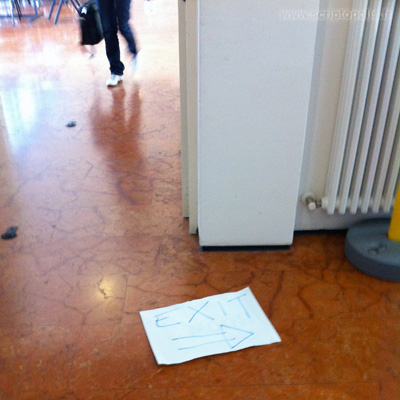Out of the doubt

Out of the doubt
What could be easier than following an exit indication? There are so many of these signs. We got used to them, we live with them, and we can rely on them even when panicking. And we know that it is not the sign itself that makes us act, but its relationship with its surrounding. It is its emplacement, and the direction of the arrow it displays, that help us to find our way out. But in some situations, we can even be aware of other kinds of resources. It is not because a sign board points actually to a place from another one, that we will follow it. After all, we do not know in advance if it is the right direction. The sign’s location has also to be somehow unsurprising. We have to have confidence in it.
For instance, that sunday, in an deserted italian faculty, the exit sign became a stop sign. We all stopped, french, english and american scholars, who were going through these corridors for the first time. On the floor, that exit sign was nothing obvious. But why? Were we distrusting its emplacement? Maybe, but why these hesitations? I think that it was less about the location itself than because the sign was not fixed to it. It was missing a sticky tape, or some staples, that would have shown the intention to put it here. There, free on the floor, that sign seemed autonomous, and it was not easy to trust it. With some fastening, we could have feel the intention, we could have take it as a reliable utterance. But here? It could have wanted to make a joke, with a little help of a gust of wind that would have placed it here randomly.
So, instead of helping us to go ahead, that sign stopped us. And we finally followed his direction, only after seeing some dauntless scholars coming back from the other direction where they had found closed doors.






